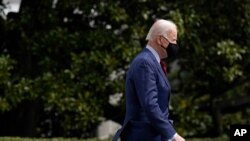With money from the $1.9 trillion U.S. coronavirus relief deal beginning to course through the world’s biggest economy, President Joe Biden’s economic advisers are preparing an even bigger economic stimulus, a possible $3 trillion package to repair the country’s aging infrastructure and -- they say -- invest in the economy of the future.
Details of the new package have yet to be laid out publicly, but Biden campaigned for the presidency last year on the need to upgrade roads and bridges, modernize airports and transit systems and expand broadband technology. Biden said he would help pay for it by raising taxes on corporations and individuals earning more than $400,000 a year.
The evolving plan envisions a much broader definition of infrastructure than just physical structures. It is likely to include reducing carbon emissions by expanding the use of renewable energy, narrowing economic inequality and providing free community college enrollment for the masses and universal pre-kindergarten education.
The coronavirus relief measure that Biden pushed through Congress solely with the support of Democratic lawmakers over unified Republican opposition was aimed at ramping up vaccinations against the virus and providing aid for hard-hit businesses devastated by the pandemic. The Biden administration envisions the new spending as preparing the economy for the years ahead.
In January, as he took office for a four-year term, Biden described the economic boost as part of his “Build Back Better” plan. But infrastructure deals in Washington have often foundered amid disputes among lawmakers over what to fund and how to pay for it.
During the administration of former President Donald Trump, plans for “Infrastructure Week” events were overshadowed by more urgent issues and quickly forgotten.
Biden’s press secretary, Jen Psaki, said recently that discussions on what might ultimately be included in the new proposal remain fluid.
“President Biden and his team are considering a range of potential options for how to invest in working families and reform our tax code so it rewards work, not wealth,” Psaki said. “Those conversations are ongoing, so any speculation about future economic proposals is premature and not a reflection of the White House’s thinking.”
Some aspects of the eventual plan put forth by the Democratic president might appeal more to Republican lawmakers than others, with road and bridge repairs high on the list of what lawmakers can point to when they run for reelection.
Paying the bill for the upgrades is more problematic.
“Anybody making more than $400,000 will see a small to a significant tax increase,” Biden said last week on ABC’s “Good Morning America” show.
Senate Republican leader Mitch McConnell told reporters, “I don’t think there’s going to be any enthusiasm on our side for a tax increase.”
In the politically divided Congress, where Democrats narrowly control both the Senate and the House of Representatives, Biden used a legislative tactic available for spending proposals to narrowly push through the coronavirus relief deal on a simple majority vote.
With the infrastructure proposal, he may need to seek support from at least 10 Republicans to close off the threat of a filibuster in the Senate, which is divided with 50 Republicans and 50 Democrats.
Alternatively, he could seek to again deploy the same legislative tactic that was used to pass the relief bill on a straight party-line vote, with Vice President Kamala Harris providing the tie-breaking vote in the Senate.
No date has been set for announcing Biden’s infrastructure proposal.









